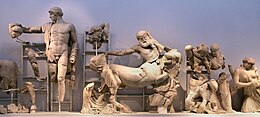Archaeological Museum of Olympia
Appearance
 | |
 | |
| Established | 1982 (New museum) |
|---|---|
| Location | Ancient Olympia, Elis, Greece |
| Type | Archaeological museum |
The Archaeological Museum of Olympia (Greek: Αρχαιολογικό Μουσείο Ολυμπίας) is one of the great museums of Greece in Olympia, Elis, and houses artifacts found in the archaeological site of Ancient Olympia.
History of the museum
The museum was built opposite the excavation site in a valley northwest of the Kronion hill. Designed by Patroklos Karantinos,[1] it was officially opened in 1982. One of the best known exhibits is the Nike of Paeonius, which is featured on the medals awarded during the 2004 Summer Olympics in Athens.
Collections

- Collection of terracottas (prehistoric, Archaic and Classical periods).
- Collection of bronzes.
- Collection of sculptures (Archaic up to the Roman periods).
- Collection from the Olympic Games.
Notable exhibits
- The Hermes bearing the infant Dionysus by Praxiteles
- The Nike of Paeonius
- Zeus carrying Ganymedes
- Pediments of the Temple of Zeus
- The helmet of Miltiades
- Miniature bronze statue of a horse
The statue of Apollo from the west pediment of the Temple of Zeus was depicted on the obverse of the Greek 1000 drachmas banknote of 1987-2001.[2]
Gallery
See also
- Ancient Olympia
- Ancient Olympic Games
- List of museums in Greece
- Praxiteles
- Statue of Zeus at Olympia
References
- ^ The Archeological Museum at Olympia
- ^ Bank of Greece. Drachma Banknotes & Coins: 1000 drachmas Archived October 5, 2007, at the Wayback Machine. – Retrieved on 27 March 2009.
External links
Wikimedia Commons has media related to Archaeological Museum of Olympia.
- Hellenic Ministry of Culture and Tourism
- Hellenic Ministry of Foreign Affairs[permanent dead link]
- Archaeological Museum of Olympia - Ebook by Latsis Foundation
- www.planetware.com
37°38′36.30″N 21°37′45.80″E / 37.6434167°N 21.6293889°E
You can help expand this article with text translated from the corresponding article in French. (September 2014) Click [show] for important translation instructions.
|




